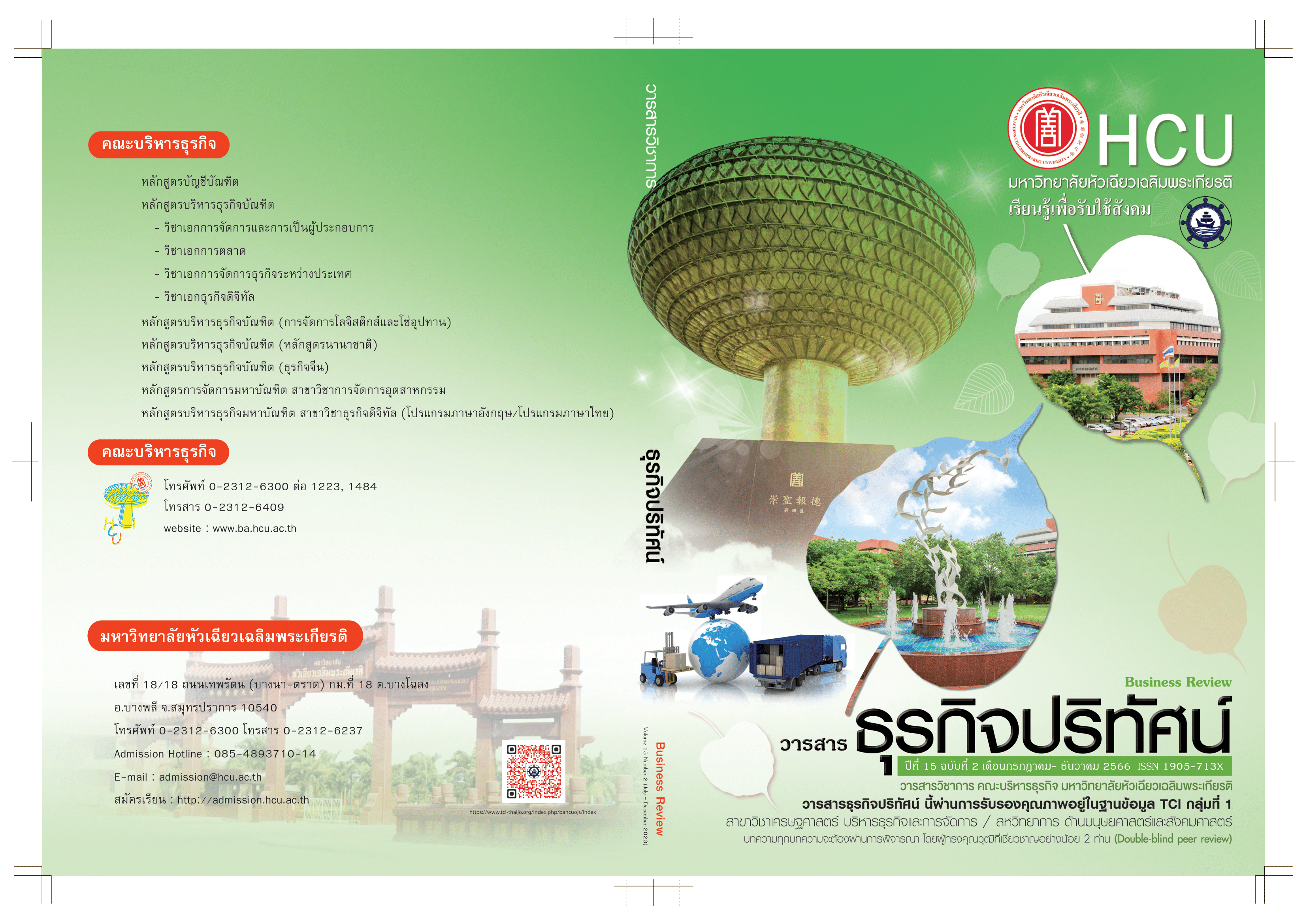The Influence of Channel Integration Quality Affecting Purchasing Intention of Fast Fashion Product via Omni Channel
Keywords:
Omnichannel, Purchase Intention, Fast FashionAbstract
The aim of this research is to investigate the influence of channel integration quality upon purchase intention for fast fashion products by omni channel retailing. Data was collected from 400 Thai omni channel consumers who have purchases fast fashion products. Multiple linear regression (MLR) was used. The result found that there is a significantly positive relationship exists between process consistency, service channel choice breadth, transparency of channel-service configuration, and content consistency with purchase intention for fast fashion products by omni channel retailing. In addition, these findings significantly indicate a different level of purchase intention for consumers using omni channel services, and those who do not.
References
Beck, N., & Rygl, D. (2015). Categorization of multiple channel retailing in Multi-, Cross-, and Omni-Channel Retailing for retailers and retailing. Journal of Retailing and Consumer Services, 27, 170-178.
Chaiseri, V. (2018). Guideline for doing omni channel strategy in department store in Thailand. Master’s Thesis, Marketing Management Commerce and Accountancy Thammasat University, Thailand.
Doyle, S., Moore, C., & Morgan, L. (2006). Supplier management in fast moving fashion Retailing. Journal of Fashion Marketing and Management, 10(3), 272-281.
Fishbein, M., & Ajzen, I. (1975). Belief, attitude, intention and behavior: An introduction to theory and research. Massachusetts: Addison-Wesley.
Grewal, D., Roggeveen, A.L., & Nordfält, J. (2017). The future of retailing. Journal of Retailing, 93(1), 1-6.
Hayes, S., & Jones, N. (2006). Fast fashion: a financial snapshot. Journal of Fashion Marketing and Management, 10(3), 282-300.
Hossain, M. S., Zhou, X., & Rahman, M. F. (2018). Examining the Impact of QR Codes on Purchase Intention and Customer Satisfaction on the Basis of Perceived Flow. International Journal of Engineering Business Management, 10, 1-11.
Krueger, J. (2015). Omni-Channel Shoppers: An Emerging Retail Reality. Retrieved March 20, 2020, from Think with Google Website: http://think.storage.googleapis.com/docs/omni-channelshoppers-an-emerging-retail-reality.pdf
Koetsire, J. (2019). 2000-Consumer Study: 68% Of Shoppers 'Click And Collect,' Or Buy Online And Pick Up In-Store. Retrieved March 18, 2020, from Forbes Website: https://www.forbes.com/sites/johnkoetsier/2019/03/11/hope-for-brick-and-mortar-retail-68-of-shoppers-click-and-collect-or-buy-online-and-pick-up/#7867d9a47708
Lazaris, C., & Vrechopoulos, A. (2014). From multichannel to “omnichannel” retailing: review of the literature and calls for research. In 2nd International Conference on Contemporary Marketing Issues (ICCMI). Athens, Greece.
Lee, Z. W. Y., Chan, T. K. H., Chong, A. Y. L., & Thadani, D. R. (2019). Customer engagement through omnichannel retailing: The effects of channel integration quality. Industrial Marketing Management, 77, 90-101.
Lynch, S., & Barnes, L. (2020). Omnichannel fashion retailing: examining the customer decision-making journey. Journal of Fashion Marketing and Management: An. International Journal, 24(3), 471– 493.
Melsted, L. R. (2015). Retailers turn to omnichannel strategies to remain competitive. Retrieved March 18, 2020, from Forbes Website: https://www.forbes.com/sites/samsungbusiness/2015/02/09/retailers-turn-to-omnichannel-strategies-to-remain-competitive/#1d08e9c34d45
Mosquera, A., Pascual, C. O. & Ayensa, E. J. (2018). Understanding the customer experience in the age of omni-channel shopping. Icono 14, 15(2), 166-188.
Nunnally, J. C. (1978). Psychometric theory (2nd ed.). New York: McGraw-Hill.
PwC. (2016). Moda por un tubo? Informes PwC Retail y Consumo. Retrieved March 20, 2020, from PWC Website: www.pwc.es/es/publicaciones/retail-y-consumo/moda-por-un-tubo-relacion-cliente-omnicanal-sector-moda.html
Rigby, D. (2011). The Future of Shopping. Harvard Business Review, 89, 65-76.
Rosman, T. (2015). Investigating omni-channel banking opportunities in Sweden: From a user perspective. Master’s Thesis, KTH Royal Institute of Technology, Sweden.
Schiffman, L. G., & Kanuk, L. L. (2000). Consumer Behavior (7th ed.). Wisconsin: Prentice Hall.
Simone, A., & Sabbadin, E. (2018). The new paradigm of the omnichannel retailing: key drivers, new challenges and potential outcomes from the adoption of an omnichannel approach. International Journal of Business and Management, 13(1), 85-109.
Shankar, V. (2014). Shopper marketing 2.0: Opportunities and challenges. Review of Marketing Research, 11, 189-208.
Shen, X. L., Li, Y.-J., Sun, Y., & Wang, N. (2018). Channel Integration Quality, Perceived Fluency and Omnichannel Service Usage: The Moderating Roles of Internal and External Usage Experience. Decision Support Systems, 18, 61-73.
Sheridan, M., Moore, C., & Nobbs, K. (2006). Fast fashion requires fast marketing: The role of category management in fast fashion positioning. Journal of Fashion Marketing and Management, 10(3), 301-315.
Sousa, R., & Voss, C. A. (2006). Service quality in multichannel services employing virtual channels. Journal of Service Research, 8(4), 356-371.
Swaid, S. I., & Wigand, R. T. (2012). The Effect of Perceived Site-To-Store Service Quality on Perceived Value and Loyalty Intentions in Multichannel Retailing. International Journal of Management, 29(3), 301-313.
Verhoef, P.C., Kannan, P.K., & Inman, J. J. (2015). From multi-channel retailing to omni-channel retailing introduction to the special issue on multi-channel retailing. Journal of Retailing, 91(2), 174-181.
Downloads
Published
How to Cite
Issue
Section
License
Copyright (c) 2023 Business Review Journal

This work is licensed under a Creative Commons Attribution-NonCommercial-NoDerivatives 4.0 International License.
All articles published in the Business Administration and Management Journal Review are copyrighted by the journal.
The views and opinions expressed in each article are solely those of the individual authors and do not represent those of Huachiew Chalermprakiet University or any other faculty members. Each author is fully responsible for the content of their own article. Any errors or issues found are the sole responsibility of the respective author.




